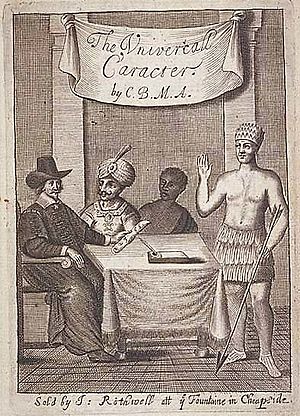Cave Beck facts for kids
Cave Beck (born 1623 – died 1706) was an English schoolmaster and a church leader. He wrote a famous book called The Universal Character in 1657. In this book, he suggested a universal language that everyone could understand. It was based on a system of numbers.
Contents
The Life of Cave Beck
Cave Beck was born in London in 1623. His father, John Beck, was a baker. Cave went to a private school in London. Later, in 1638, he went to St. John's College, Cambridge. He earned his first university degree, a Bachelor of Arts (B.A.), in 1642.
Beck's Early Career
In 1642, Beck started training to be a lawyer in London. However, he did not finish his law studies. In 1643, he was in Oxford. This was during the English Civil War. King Charles I had his headquarters there. Because of the King's support, Beck received another degree, a Master of Arts (M.A.), in 1643.
Headmaster and Church Leader
From 1650 to 1657, Beck was the headmaster of Ipswich School in Ipswich, Suffolk. There is even a street named Beck Street in Ipswich after him. He left the school in 1657 but returned for six months in 1659.
In 1657, he also became a curate at St. Margaret's Church in Ipswich. A curate is a church assistant. Beck worked closely with the Viscounts of Hereford for many years. He even tutored the Viscount's son, Leicester Devereux.
In 1660, Beck traveled to the Netherlands with Viscount Hereford. They were part of a group that brought King Charles II back to England. This event is known as The Restoration. When Beck returned, he was given charge of several churches. He held these church positions until he died.
Beck's Final Years
Cave Beck died in Ipswich in 1706. He left everything to his wife, Sarah. It is believed he did not have any children.
Beck's Universal Language
Beck is best known for his book, "The Universal Character". It was printed in London in 1657. The full title explained its purpose: "The Universal Character, by which all Nations in the World may understand one another's Conceptions, Reading out of one Common Writing their own Mother Tongues.". This means it was a way for people from different countries to understand each other using a shared writing system.
How the Language Worked
Beck's universal language was based on a list of about 4,000 basic words. He called these "radicals." Each radical was given a number. For example, abandon was 1, and zone was 3996.
You could change these basic words into different parts of speech. You did this by adding certain prefixes. For example:
- r2518 meant labour (the action).
- p2518 meant labourer (a person who labours).
- pf2518s meant female labourers.
- t2518 meant in a laboured manner.
He also had suffixes for verb tenses. For example, ad2518 meant I have laboured.
Speaking the Numbers
Beck also created rules for how to say the numbers. This meant the language could be spoken as well as written. Here are some examples:
- 1 was pronounced "On"
- 2 was pronounced "Too" or "To"
- 3 was pronounced "Tre" (like "tray")
- 4 was pronounced "For" (like "fore") or "Fo"
- 5 was pronounced "Fi" (like "fie")
Impact of the Language
Many people were interested in Beck's system at the time. However, it was not widely adopted. Still, experts today say that Cave Beck was very important. He created the first complete "Universal Character" system to be printed. This was not just in Britain, but likely in all of Europe!
The front page of Beck's book has an engraving by William Faithorne. Many believe the picture of the European on it is actually a portrait of Cave Beck himself.
See also
- Pasigraphy
- George Dalgarno (1635–1682) and John Wilkins (1614–72) who each devised a universal character.
- Joachim Becher proposed a numerically based universal language scheme in his book "Character pro notitia linguarum universali" in 1661.
- Athanasius Kircher (1601/2 – 1680) proposed a universal language in "Polygraphia nova et universalis" in 1663.


